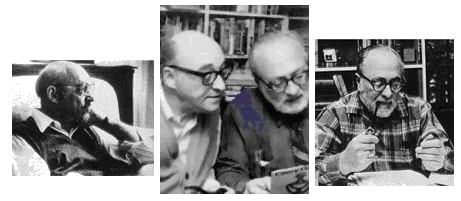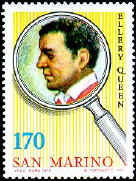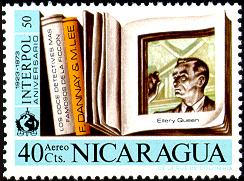
 |
|
TO PAGE: 1 • 2 • 3 • 4 • 5 • 6 • 7 • 8 • 9 • 10 • 11 • 12 • 13 • 14 • 15 |
![]()
INFLUENCES
 When the cousins entered the McClure contest Van Dine was at his peak of success. The influence their idol had is obvious. As JJMcC pointed out Ellery Queen retires to Italy: exactly where Van Dine had said Philo Vance had retired. Ellery Queen is a pseudonym to conceal the real identity of the sleuth as was Philo Vance. They both like to use pompous literary references. Vance got access to the crimes through his friend Markham while Ellery's connection to the investigation was given by his father. Sergeant Velie, Doc Prouty and even Djuna all had a counterpart in the Van Dine novels as respectively Sergeant Heath, Dr. Doremus and the butler Currie. Ellery Queen (detective and author) went through several distinct changes in his series. Gradually, he developed a more personal style, although he always was faithful to the puzzle plot, intuitionist tradition of the Van Dine school. Along with Agatha Christie and John Dickson Carr, he was one of the three major writers of the puzzle plot detective story. As Jon Tuska pointed out Ellery Queen carried the classical plot as pioneered by Van Dine forward for another generation and created a haven for those readers who wanted to believe even for a moment or two, that the complexities of modern life could be reduced to a mere problem in deduction.
And Poe said: Let there be a detective story.
Despite this adoration Queen's solution to the concealed object problem are
slightly different from Poe's. In "The Purloined Letter", the missing
letter is concealed in a conspicuous place, one that is so "obvious" that no one
looks there. EQ's approach is related, but somewhat different. In EQ's tales, a public
ritual of some sort is often taking place. There is a container at the center of this
ritual, and the missing item is hidden inside the container. For example, in "The
Trojan Horse", there is a football game about to begin, and the missing gems are
hidden in the football itself. The containers can seem like womb or egg symbols. Often
they will be propelled or ejected outside the perimeter of the main search area. The
propulsive device is often another object, one with phallic or male symbolism. In "The
Trojan Horse" these propulsive figures are the football players themselves. The next great impact proved to be an
even more shattering experience: Maurice
Leblanc's Arsène Lupin, that hero of extraordinaire verve, supreme cockiness, and
flaming spirit. He was the "cool man", whereas Holmes was, by comparison the
"cold" man, and Lupin's appeal to Fred's emotions was more compelling than
Holmes' appeal to his intellect. In Fred Dannay own words: "Maurice Leblanc's plots, in books like 813 (his masterpiece), had an enormous
influence, technical and creative on my own imaginativeness and I
acknowledge this debt
after all this years."
Novelist and poet Thomas Hardy
(Jun 2. 1840 – Jan 11. 1928)
is
considered to be a determinist mostly because his protagonists are either
controlled by the nature of things or by superior powers. In other words,
independence of the Human Will in Hardy's fiction is hard to affirm
because man's struggle against the "will" only leads to his future failures.
(Fazel Asadi Amjad, Esmaeil Najar Daronkolae -
Thomas
Hardy and Urbanization: The Role of Determinism in Tess of the D’Urbervilles). As for Manny Lee he once (1967)
stated that for "boys of the slums" he could only turn to
Horatio
Alger's heroes, who were the most insufferable prigs
in American literature or if he wished to step out of his class, to the
Merriwells, Frank and Dick, or Dink
Stover in Yale.
With some under-the-bedcovers illicit delights like the paperback Wild
West Adventures. |


 Above left: Celebrated investigators of fiction on a set (700,000) issued on July 12. 1979. Multicolour offset combined with recess by the I.P.Z.S. in sheets of 40 on white unwatermarked paper perf. 13 x 14, with PVA gum, engraved by Giorgio Toffoletti. Above right: issued commemorating the 50th Anniversary of Interpol. |
|
|
|
|
| The concept that the three great writers of the classical detective novel are Christie, Carr and Queen is not new. The linking of the three names was seemingly first used by Anthony Boucher. He casually listed them once together in passing as the "greatest names" in detective fiction. More centrally and emphatically, Jon L. Breen described them as the big three of the classical novel. He also expressed his disappointment that there weren't more writers like these three lurking in detective tradition. Since Breen, this grouping, has been fairly casually referred to, in many other writers. It is beginning to take on the status of a cliché or a truism, as if it were a well recognized fact. People often cite the three merely to invoke a tradition, that of the well done puzzle plot novel, rather to launch a complex argument about detective history. For example, a reviewer might write (accurately) that Bill Pronzini's Case File excellent puzzle plot stories contains in the tradition of Christie, Carr and Queen. A basic excellence seems to be recognized here. Ultimately, one might say reality is source of this idea. The Big Three are the only detective writers I yet know of, who wrote a large number of brilliantly puzzle plotted novels. Much of his technique that would later dominate Ngaio Marsh's novels. There is the floor plan, and the wanderings of the characters through it. They are well defined and varied types, each with its own active interest in the outcome. The chapter titles are all schematic. One may have wondered if Marsh is a Van Dinean; perhaps it would be more accurate to wonder if she were directly influenced by Ellery Queen. (Michael E.Grost) | |
 |
|
|
Shizuko Natsuki (1938 - 2016) was not only a well-known Japanese writer of mysteries. The sister of Fred's publisher in Japan, Kozo Igarashi, also the interpreter for Fred Dannay & Rose Koppel when they first visited Japan in 1977. So it should come as no surprise to know that Shizuko Natsuki named one of her works as a tribute to Ellery Queen W no Higeki (1982). W's Tragedy fits nicely into the series of Drury Lane titles. The book was made into a movie in 1984 with the English title Murder at Mt. Fuji, and was also turned into TV series several times. In his article "Ellery
Queen is alive and Well and Living in Japan" Ho-Ling Wong describes
Ellery Queen's influence on Japanse writers. Other popular writers of the New Orthodox School are Rintarō Norizuki and Alice Arisugawa. Both writers are strongly influenced by Ellery Queen. Both of them have named their protagonists after themselves, like their great example. Both writers often insert a Challenge to the Reader in their stories. As one can derive from his first name, Arisugawa often delves into imagery of Alice in Wonderland, just like Ellery Queen, while Norizuki Rintarō’s characters mimic Ellery Queen almost exactly. His protagonist is a writer, also called Norizuki Rintarō, who helps his father, a police inspector, mirroring the Inspector Queen dynamic. Norizuki’s prize-winning short story “An Urban Legend Puzzle” is a great example of the New Orthodox School. While it features a classic puzzle plot, the incorporation of urban legends is distinctly modern. More recent writers of this type include names like Natsuhiko Kyōgoku and Mori Hiroshi. Writer-artist Gōshō Aoyama provided ingenious plots and puzzles that would entertain any crime fan for his Detective Conan series, ... more on those you read here. |
|
 |
|
|
Even the included map of Stratford Court did remind us of the map provided in Queen's The Player on The Other Side ... The story in the novel Queen City Corpse (2018) takes place during a QueenCon mystery conference in Cincinnati and I suspect there may well be more references "hidden" in his work. So was this really the first reference to Ellery Queen he made? Dan clarified this himself by stating that his primary references to EQ were in Bookmarked for Murder (12 times) and Queen City Corpse (17 times). Finally adding: "I also mentioned the name in four other books. But really, my work is very much influenced by him. I very often have dying messages and a false solution before the real one -- classic Queen devices!" |
|
|

|
| Introduction | Floor Plan | Q.B.I. |
List of Suspects | Whodunit? | Q.E.D. | Kill as directed | New | Copyright Copyright © MCMXCIX-MMXXV Ellery Queen, a website on deduction. All rights reserved. |